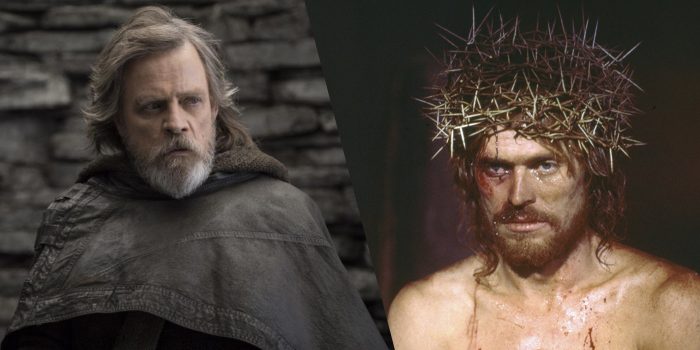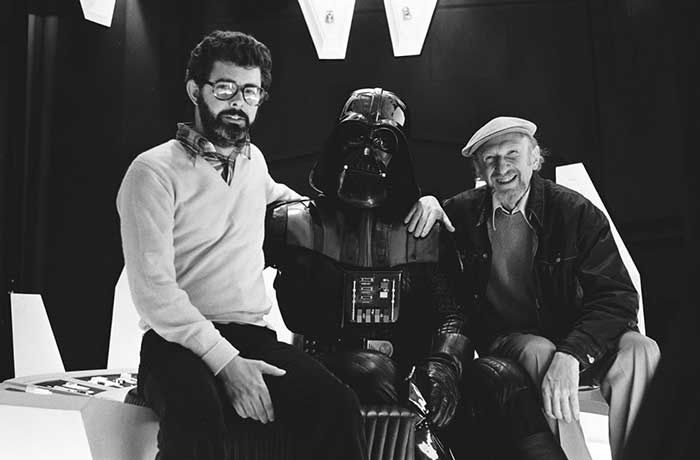
(Welcome to The Movies That Made Star Wars, a series where we explore the films that inspired or help us better understand George Lucas’s iconic universe. In this edition: The Last Temptation of Christ.)
Roger Ebert famously called movies machines of empathy. He said that you can watch a film and walk in the shoes of another person and see what their plight was like and feel it for yourself. In some cases, with some audiences, that effect backfires and it’s a curious thing. Some audiences don’t want to feel those things or walk in the shoes of that particular character in that particular way. They don’t like how the character reacts to the situations before them because it’s not how they would react, or maybe they find them inconsistent with the character.
I think this is a phenomenon we’ve seen with Star Wars: The Last Jedi, thanks to its intriguing and complex treatment of Luke Skywalker. As I watch The Last Jedi and the strident backlash behind the character, I looked back into film history and found an example that I think is instructive to helping understand some of the rejections of the film. That film is Martin Scorsese’s The Last Temptation of Christ.
I asked Rian Johnson about whether or not The Last Temptation of Christ influenced his treatment of Luke Skywalker because I think it lines up one to one with Luke’s journey in The Last Jedi. Johnson admitted it didn’t, though he found the comparison fascinating.
Just because it wasn’t a direct influence, though, doesn’t mean that there isn’t a tie between the two films. It can still teach us quite a bit.
This post contains spoilers for both Star Wars: The Last Jedi and The Last Temptation of Christ.
The Deity as Human
“The dual substance of Christ—the yearning, so human, so superhuman, of man to attain God…has always been a deep inscrutable mystery to me. My principle anguish and source of all my joys and sorrows from my youth onward has been the incessant, merciless battle between the spirit and the flesh… and my soul is the arena where these two armies have clashed and met.”- Nikos Kazantzakis, The Last Temptation of Christ
This quote is how Scorsese began his adaptation of The Last Temptation of Christ, a film that offers a differing view of the son of God. Jesus in this film is played by a remarkably human Willem Dafoe, who struggles between the divine nature in himself and the fallibility of being human. He’s confused and doesn’t know the answers, but gets by the best he can. He knows he needs to sacrifice himself, but doesn’t have the courage to do it so he asks Judas (Harvey Keitel), his best friend and confidante, to betray him. Jesus goes through his trials and realizes it’s within his own power to stop his own suffering. He can lead a quiet life outside the ministry he’d taught after his most beloved student turns on him.
The Jesus in this film is torn between the destiny everyone tells him he has and his own human desires. Does he have agency? Or is everything the will of God? Sounds very much like the struggle of prophecy, balance, and greater destiny that plagues all three generations of Skywalker men in the numbered entries in the Star Wars saga.
In The Last Temptation, John the Baptist, like Yoda and Obi-Wan did for Luke, tries to convince Jesus to kill, to strike out, to burn. But Jesus knows a better way. “If I was a woodcutter, I’d cut,” he tells the baptist. “If I was a fire, I’d burn. But I’m a heart, and I love. That’s all I can do.”
This is, spiritually, the same thing as Luke’s “I will not fight you,” in Return of the Jedi. This is the message he takes with him to Ahch-to. This is the message that he finds a way to win with in his final confrontation with Kylo Ren and is mirrored by Rose’s statement to Finn on Crait. “That’s how we’re going to win. Not fighting what we hate, but saving what we love.”
It’s earlier in his life when Luke has a difficult time balancing between each half of his nature, the same way Dafoe’s Jesus grapples with the dueling humanity and divine inside him. Luke tries to win with love and love alone but his anger gets the better of him, both when he confronts Vader and when he has that fleeting moment of instinct where he considers killing his nephew. Luke is conflicted by both halves of his nature and needs to choose one.
George Lucas was a student of comparative mythology, so it’s no wonder that themes from the Christ story would find their ways into Star Wars, up to and including Anakin’s virgin birth.
The Last Temptation of Luke
Luke’s arc follows a similar trajectory as Jesus’s in The Last Temptation, where he’s given in to his last temptation and removed himself to quiet isolation, letting others fight his battles for him. Hadn’t he given the galaxy enough? What more could he give? He’d done his good. For Luke, this temptation is to live a life of non-violent peace in hopes of breaking the cycle of violence the Jedi seem destined to participate in.
In The Last Temptation of Christ, Harvey Keitel’s Judas gets his best scene at the end of the film. He arrives with righteous fury and chides Jesus for ignoring his purpose and turning his back on his duty after failing his final temptation. The Last Jedi casts Rey in this role. She arrives on Ahch-To, determined to shake Luke from his doldrums and bring him back into the fight for good. She tells him, essentially, that he’s done the wrong thing and given in to the wrong temptation. Where Jesus practically blinks and finds himself suffering back on the cross, Luke doesn’t have that power. Luke certainly wakes up, albeit slowly. But when he catches his would-be apprentice fraternizing with his nephew and she leaves having rejected him, Luke knows what he has to do. He gets on that proverbial cross with his sacrifice on Crait. He realizes that he’s more important as a story, a myth, a martyr, and he was selfish to think he could live out his life in any other way. He gives the world a spark of hope, then disappears, passing into myth.
At the end, no matter how difficult their trials had been, both Luke and Jesus end with a sense of peace and greater purpose. And both live beyond this moment of sacrifice, heading into immortality and an eternal life.
Blasphemous Reaction
Perhaps the thing that The Last Temptation of Christ and The Last Jedi have most in common are the public reactions over the handling of a figure viewed by many as a mythologized deity. The stories of both Luke Skywalker and Jesus are cultural touchstones that many have used as gospel, literal and figurative, to guide their lives. When The Last Temptation of Christ was released, there were protests and boycotts organized because evangelical groups were offended that the film represented a departure from the gospel narrative they knew. They picketed the movie studio that produced the film and even theaters that were showing it. One prominent evangelist, Bill Bright, offered to buy the film’s negative so that he could destroy it. A Catholic nun was quoted as saying the film was “the most blasphemous ridicule of the Eucharist that’s ever been perpetrated in this world” and “a holocaust movie that has the power to destroy souls eternally.” Martin Scorsese suffered death threats from these same groups.
Does that sound a lot like the over-zealous reaction of some to The Last Jedi? There were many who felt that this treatment of Luke was a mishandling of the character and an outright assassination. Others boycotted the film for deviating from the Legends universe of Star Wars material. There have been petitions to remove the film from canon and, like Bill Bright’s plea to buy the negative to destroy, a group of fans have offered to pony up the cash to remake The Last Jedi in their own image. Like Scorsese, Johnson also had to suffer threats of death and mortal danger as a risk for making challenging art.
It might be hard to admit, but some Star Wars fans approach the text with the same zeal as religious fanatics and find the doctrine of Star Wars just as inviolable and Christians find their sacred texts. Luke is a Jesus figure. Seeing him in a light they hadn’t pondered or prepared for was akin to blasphemy.
And I find it fitting. For many Star Wars fans, as controversial as it might seem to say, Luke Skywalker is a more important figure in their personal philosophy than Jesus Christ. I certainly find that true for myself. Rian Johnson’s view of Luke helps us better understand his character by looking at him from a different angle, the same way Scorsese’s interpretation of Jesus offered that figure a new, more human lens to be viewed through.
Perhaps this realization can give us a window of understanding into that small but loud flurry of disappointing reactions on the part of some sectors of fandom.

Irvin Kershner
An unrelated but fascinating connection that Star Wars shares with The Last Temptation of Christ is the participation of Irvin Kershner, the director of The Empire Strikes Back. He played Zebedee, a man who tried to stone a woman to death and was stopped by Jesus.
Kershner was a mentor to George Lucas during his time at USC and that’s how he ended up getting the job to direct The Empire Strikes Back. What’s less clear is why The Last Temptation of Christ was his feature film debut as an actor. Regardless, he is perfectly fine in the role and looks right at home in Scorsese’s painterly vision of the life of Christ.
The Last Temptation of Christ
The Last Temptation of Christ is a fascinating alternate view of the life and passion of Christ. Willem Dafoe plays Jesus with a human edge, with equal parts fury and schizophrenia, that is far different and more relatable than other depictions of the character. Peter Gabriel offers a haunting score that brings in period musical instruments and Thelma Schoonmaker’s editing here is as good as any she did in her collaboration with Scorsese. There are moments of unorthodox work that are the hallmark of the Scorsese/Schoonmaker collaboration and they’re not to be missed. The cinematography by Michael Ballhaus evokes dusty versions of Renaissance paintings, capturing those color palates and moments in vivid live action.
Taken as a whole, the film offers a layered, complex look at the spiritual through artistic blasphemy and comes out better for it. And there’s nothing wrong with that. I’d say The Last Jedi does the same thing, but to even greater effect. Both offer us new views of complicated figures our culture has deified and both help us understand them better.
***
The Last Temptation of Christ is available on most streaming services for a fee and the Blu-ray is being distributed by The Criterion Collection, which ought to be the preferred viewing method.
The post The Last Temptation of Skywalker: The “Blasphemy” of ‘Star Wars: The Last Jedi’ Illuminates a Martin Scorsese Masterpiece appeared first on /Film.
from /Film https://ift.tt/2mtagm8
